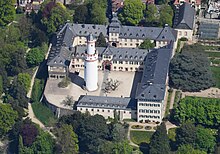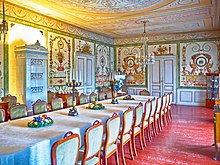

Bad Homburg Castle (Schloss Bad Homburg) or Homburg Palace is a castle and palace in the German city of Bad Homburg vor der Höhe. Originally the residence of the Landgraves of Hesse-Homburg, it was first built in the 12th century.


All but the keep was demolished in 1660 by Frederick II, Landgrave of Hesse-Homburg. He replaced the old castle with a new one designed by Paul Andrich between 1680 and 1685. Its grounds and gardens were landscaped in the 18th and 19th centuries, including the addition of the Gothic House. It was built for Princess Elizabeth, a daughter of King George III of the United Kingdom, the wife of Frederick VI, Landgrave of Hesse-Homburg. The couple had the palace renovated and furnished in contemporary style, including the English Wing. In particular, the British princess realized her passion for garden art, which can still be experienced in the castle park today.
After Prussia's annexation of Hesse-Homburg in 1866 following the Austro-Prussian War, it became a summer residence for the kings of Prussia. William I stayed at the castle several times, as did his son and successor Frederick III and Frederick's wife Victoria, a daughter of the British Queen Victoria. The castle was a particular favourite of Frederick and he added bathrooms, telephone rooms and electricity and merged some rooms. His son William II and the latter's wife Augusta Victoria also used the palace as a summer residence and refurbished the Royal Wing.
After the German Revolution of 1918–1919 the castle was administered by the Free State of Prussia. After Hitler came to power in 1933, he offered William II, who was living in exile in Huis Doorn in the Netherlands, a return to Germany to bring him under his control, and Homburg Palace as a residence, but the ex-Kaiser refused. After the dissolution of the state of Prussia in 1945, the palace was taken over by the state of Hesse. From 1947 it housed the Verwaltung der Staatlichen Schlösser und Gärten Hessen (Hesse Administration for State Castles and Gardens). Today, it is a museum.